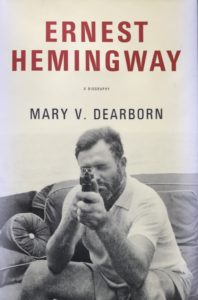
ERNEST HEMINGWAY—A Biography by Mary V. Dearborn (Knopf, New York, 2017) [Photograph by Edith-Mary Smith]
Only after visiting ‘Hemingway House’—Ernest Hemingway’s former home, now a museum, in Key West, Florida—did I become a keen fan of Ernest Hemingway, the writer.
For me, the appeal came partly from his writing (crisp sentences, blunt and to the point), and, to a much larger extent, from how he lived his life. He lived the writer’s life as he envisioned it: Daring in that he went to war (in Spain and Europe as a war correspondent and ambulance driver); brave in that he boxed and went to bull fights, sometimes risking himself in the arena; bohemian in that he lived in Paris in the golden years of such artists as Dali and Picasso, and of such writers as F. Scott Fitzgerald and, to give credit where it’s due, as Ernest Hemingway. From his own life, he drew the inspiration for the characters of the novels that he wrote.
Dearborn’s biography spans the entire life of Ernest Hemingway, from birth to suicide, and she pulls no punches.
Wars and bull fights are covered in detail, as are each of Hemingway’s four wives. (All American.) The count starts with Hadley Richardson—The Paris Wife—so engagingly portrayed in Paula McLain’s novel of that name. Then Pauline (Fifi) Pfeiffer, the woman responsible (according to Hemingway’s account in A Moveable Feast) for breaking up his first marriage.
Hemingway was with Pauline when he first moved into ‘Hemingway House’ in Key West—now a tourist stop and shrine for Hemingway enthusiasts, as well as for cat lovers.
Martha Gellhorn, the well-known war correspondent, came to Key West as a tourist. She became Ernest Hemingway’s third wife. His fourth and final wife, eventually to become his widow, was the journalist-author Mary Welsh. [For an account of Hemingway’s wives, also check Naomi Wood’s Mrs. Hemingway.]
Dearborn’s biography covers the lost manuscripts, Hemingway’s confusion over gender, his fetish about hair, his manic depression, and his being oddly prone to accidents (car crash in the London Blitz and plane crash in Africa, to mention but two), and, of course, the biography covers all of the novels and many short stories.
 wars and to hear the words of John McCrae’s poem In Flanders Fields recited beside cenotaphs and war memorials around the world.
wars and to hear the words of John McCrae’s poem In Flanders Fields recited beside cenotaphs and war memorials around the world.







